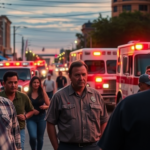**30% of Border Patrol Surveillance Cameras Offline: Implications for the Rio Grande Valley**
In a startling revelation impacting border security, a recent memo has disclosed that nearly 30% of surveillance cameras operated by the Border Patrol are offline. This development, reported by ValleyCentral.com, has significant implications for border monitoring and security efforts in South Texas, specifically the Rio Grande Valley (RGV), a region that already faces numerous challenges regarding immigration and security.
Key Points of the Memo
According to the memo from Border Patrol, the effectiveness of these surveillance cameras is considerably compromised due to outdated technology in need of significant maintenance and upgrades. Despite this technological setback, the agents continue to engage in traditional methods like “sign cutting”—a technique involving tracking of physical disturbances to detect movement across the border.
Recognizing the urgency of the situation, U.S. Customs and Border Protection has announced plans to deploy 15 additional surveillance towers along the southern border in the forthcoming months. These new towers aim to reinforce the current systems and enhance monitoring capabilities.
Local Impact and Community Concerns
For Valley residents, this news about the impaired state of surveillance cameras carries potential risks and concerns. The Rio Grande Valley, a frontline in national security discussions, may experience direct implications, both from a security and a socioeconomic perspective.
“We rely on these surveillance technologies to not only enforce border laws but also to ensure our community’s safety,” said Commissioner Rafael Sanchez, who has been actively involved in local security initiatives. “This downtime raises concerns, but it’s equally important to look forward to the upgrades planned.”
Recent Security Challenges
The report of 1.4 million fentanyl pills intercepted at Pharr, Texas, highlights ongoing concerns regarding drug trafficking routes into the United States, often targeting South Texas as an entry point. Such incidents increase the stakes in enhancing the surveillance systems and ensuring operability of existing technologies.
Local law enforcement underscores the challenges posed by both drug and human trafficking, pointing to the necessity of functional and advanced surveillance measures. Drug Enforcement Officer Emily Gomez shared, “We’re continually challenged by these operations along the border; working cameras mean quicker, more efficient responses.”
Historic and Continuing Issues
The Rio Grande Valley historically faces complex issues due to its geographical and economic position. From fluctuating security measures to economic disparities, residents have often stressed the need for consistent and reliable security infrastructure. The recent camera outages are a reminder of the infrastructural investments needed to address long-term stability in the region.
“Historically, border technology has ebbed and flowed with policy changes,” said Dr. Gabriel Torres, a border policy expert. “The focus now should be on ensuring these tools are not only upgraded but maintained as essential components of a broader security strategy.”
Potential Implications and Path Forward
Future upgrades and the deployment of additional towers could bring both challenges and opportunities. On one hand, there’s potential for improved surveillance capabilities which would enhance local security and potentially deter illegal activities. On the other, residents and officials alike express concerns over privacy and the efficiency of implementing such technologies.
The success of such initiatives will depend largely on transparent communication and collaboration between federal entities and local governments. Jose Alvarado, a local community organizer, emphasized, “Any change in border policy and technology directly affects us. Community engagement and dialogue will be vital to ensure these changes benefit rather than hinder our local way of life.”
For residents looking for more information or to express concerns, local forums and government meetings will provide platforms for dialogue. Additionally, ValleyCentral.com offers resources and updates through their online portals to keep the Valley community informed and engaged.
The revelation of non-operational cameras underscores critical issues of technology reliance and the necessity for robust, sustainable infrastructure in border regions. As changes unfold, the RGV community remains keenly aware of the balance between security, privacy, and community prosperity.







